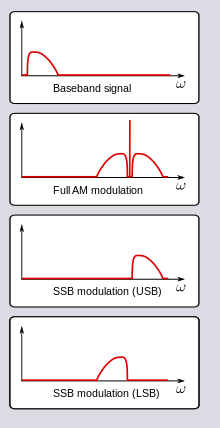...
This is rather interesting. I have mothballed all the old CB radios during the last noisy solar interference, but maybe it would be worth resurrecting them. We do occasionally use clear, quiet Family Radio channels for convoy. I believe Motorola works best unless other brands got better. But I can see by this thread, CB does open up other useful possibilities.
Perrysburg Dodgeboy wrote:
Running side band LSB=lower side band and USB=upper side band it is a ferq between the CB ferq. If you go to the higher channels you may notice a grabbled talk. That would be someone on one of the side band frequencies.
Don
Don,
Actually, FYI, you are quite correct in your quick and simple summarization.
A SSB transmission is always a transmission of frequencies between the center channels, either between the channel frequency above, or below the selected channel. Mowermech is also mostly technically correct, all except where he said, "
Actually, no.", seeming to entirely disagree with you.
Mowermech also wasn't quite right that a modulated transmission follows the precise center frequency. This is as in, I quote him, "
If you are on Channel 40, 27.405 MHz, you are broadcasting and receiving on 27.405 MHz whether you are on USB, LSB, or AM.".
The way SSB actually works is that it suppresses the carrier as mowermech stated, and you would be
receiving on 27.405 MHz, but the sideband
transmission broadcast is a band of frequencies always above the center for USB, always below for LSB, and both upper and lower bands plus the carrier for full AM. The advantage to SSB is that SSB doesn't waste power on transmitting the center carrier or a double sideband frequencies. SSB transmits only one side-band difference frequency per audio modulation, and all
allowed FCC wattage is concentrated in this
near 27.405 MHz band info. Find more at
Wikipedia.
Borrowed from Wikipedia:
Illustration of the spectrum of AM and SSB signals. The lower side band (LSB) spectrum is inverted compared to the baseband. As an example, a 2 kHz audio baseband signal modulated onto a 5 MHz carrier will produce a frequency of 5.002 MHz if upper side band (USB) is used or 4.998 MHz if LSB is used.
A mixture of audio frequencies, such as in speech, will create a multitude of nearby frequencies in the selected half-band which is detected by the exact center channel frequency that the receiver is locked/tuned to.
Wes
...
